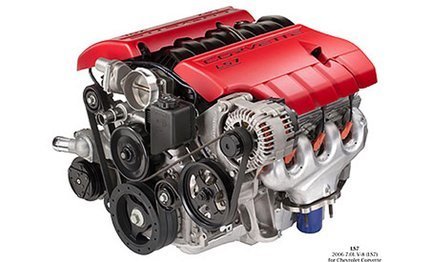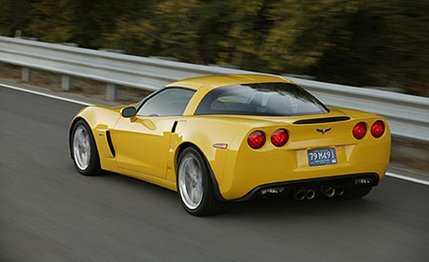
 First Drive Review
First Drive Review
The number is magic, recalling the era when Detroit dominated the world with its big, powerful, swaggering V-8s. The Chevrolet 427 V-8 first appeared as an experimental engine that powered Junior Johnson to a then-amazing 166-mph lap at Daytona in 1963. It went into production soon afterward, known variously as the Mark IV, the Chevy big-block, or simply the rat motor.
Now the 427 is back, powering the fire-breathing 2006 Z06 Corvette. Okay, so the engine actually displaces 427.6 cubic inches (7008cc), about one more cubic inch than the original. That's because this new 427 is not a reincarnation of the old rat motor. Instead, it's yet another variant of the versatile mouse motor, the small-block Chevy V-8 that is celebrating its 50th birthday this year. Even so, it's rated at 500 horsepower-more than any of the bygone 427s and 454s–and these are SAE net horses, not the bogus gross ponies from the '60s.


This V-8, dubbed the LS7, is based on the latest incarnation of the small-block architecture, which GM calls Gen IV. However, virtually every component has been re-engineered to achieve the greater displacement and higher output.
Compared with the LS2–the base C6 engine–the LS7 has a new block with a bore of 4.13 inches and a stroke of 4.00 inches (versus 4.00-by-3.62 inches). To accommodate the larger holes with the standard 4.4-inch bore spacing, Chevy engineers switched from the LS2's cast-in-iron liners to thinner pressed-in liners.
Within the LS7 block, you'll find a forged-steel crankshaft, forged-steel main-bearing caps, titanium connecting rods, and forged pistons. A dry-sump oiling system with an eight-quart reservoir ensures proper lubrication of this long-stroke engine at its 7000-rpm redline.


Making high-rpm power with just two valves per large cylinder requires optimized breathing at every stage of the intake and exhaust process. This starts with a low-restriction air cleaner and intake ducting feeding a throttle body 3.5 inches in diameter. A composite intake manifold funnels the air to unique cylinder heads with massive intake and exhaust ports, which are CNC-machined for consistent shape and contour. These ports feed lightweight 2.20-inch titanium intake valves and 1.61-inch exhausts, with sodium-filled stems for superior high-temperature durability.
The valves are positioned at 12 degrees from the cylinder bores. This angle provides better breathing and a more compact combustion chamber than the LS2's 15-degree angle does. Valve lift is a hefty 0.591 inch, using rocker arms with a 1.8:1 ratio.
Web Exclusive!
An interactive look at the comprehensive attention to detail that makes the Z06 remarkable.